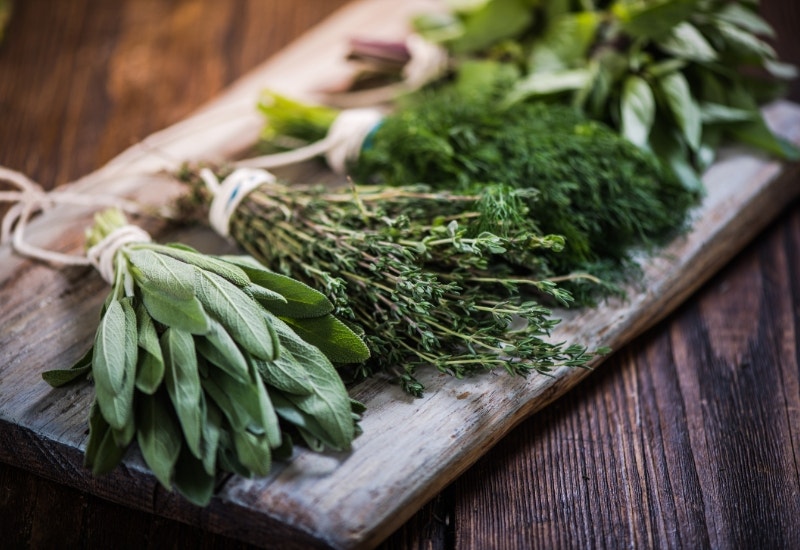How to Revive Wilted Herbs: Quick & Easy Solutions

There’s nothing more disappointing than reaching for your fresh herbs only to find them wilted and lifeless. Don’t be disheartened just yet; there are ways to revive those wilted herbs and bring them back to life. In this article, we’ll share some simple and effective methods to help you restore the freshness and flavor of your herbs, perfect for elevating your culinary creations.
How to revive wilted herbs – here are sustainable and easy techniques to rescue those wilted herbs. Begin by gathering the wilted herbs for revival, and follow the helpful advice we’ve compiled to make your herbs spring back to life.
You can skip the article and just do it like this:
You’ll be amazed at the transformation you can achieve with just a few steps. Some of these methods involve using an ice bath to shock the herbs back to life, while others recommend storing them in an air-tight container with a paper towel. By implementing these tips, your wilted herbs will be revitalized and ready to be added to your favorite dishes, enhancing their taste and adding a burst of fresh flavor.
Table of Contents
Identifying Wilted Herbs
Signs of Wilting
Wilting in herbs is a common issue, but identifying it is the first step towards revival. Look for the following signs in your herbs:
- Sagging leaves: If the leaves are limp and drooping, this indicates wilting.
- Yellowing leaves: A color change from vibrant green to dull yellow also signals wilting.
- Dry or brittle texture: Feel the texture of the leaves. Wilted leaves may lose their suppleness and become dry and brittle.
How to Revive Wilted Lettuce Today
Common Culprits: Parsley, Cilantro, and Basil
Reviving wilted herbs is essential to retain their flavor and nutritional value. Let’s discuss the common culprits – parsley, cilantro, and basil – and identify their wilted characteristics:
- Parsley: Wilted parsley will have drooping stems and curled leaves. The bright green color may fade to a dull shade.
- Cilantro: Cilantro is more delicate, so wilting is easier to spot. Its leaves will appear limp, and they might lose their vibrant green hue.
- Basil: Basil is prone to wilting. When wilted, its leaves will droop and become discolored, sometimes even turning black or brown.
Now that you’ve identified the wilted herbs, it’s time to bring them back to life. Try submerging them in an ice bath to shock them and revive their fresh, vibrant appearance.
Remember, the key to successful herb revival is to act quickly and take care of them as soon as you notice any signs of wilting.
Tips: How to Revive Wilted Herbs
Ice Water Shock Treatment
Wilted herbs can be a real letdown, but don’t worry, there’s a quick method to revive them: the ice water shock treatment. Fill a large bowl with ice and cold water. Carefully remove any bruised or blackened leaves from your wilted herbs, and then submerge them, stems and all, into the ice bath. The cold water shocks the herbs back to life. Depending on the herb and just how wilted it is, this could take as little as 15 minutes to as long as an hour. Give it a try!
Soaking in Cool Water
If you don’t have ice on hand, you can still revive your herbs by soaking them in cool water. Start by cutting about ½″ off the stems and discarding any bruised or damaged leaves. Then, make a cool water bath to soak the bunch in it. The cold water shock gradually brings the herbs back to life. The amount of soaking time varies, but you’ll know when they’re ready – the herbs will start looking refreshed.
Proper Storage Techniques
Proper storage is essential for keeping your herbs fresh and preventing them from wilting in the first place. Begin by drying your picked herbs thoroughly with a clean kitchen towel or salad spinner. Store them in an air-tight container lined with a paper towel on the top and bottom to absorb any extra moisture. You can also do this in a Ziploc bag. Make sure to use your herbs within a couple of days to enjoy their maximum freshness and flavor.
Reviving wilted herbs is possible with these simple techniques: giving them an ice water shock treatment, soaking them in cool water, and storing them properly. Trust your experience and intuition; your wilted herbs will be as good as new!
Preventing Wilting in the Kitchen
When it comes to preventing wilted herbs in your kitchen, a little attention and care can go a long way. In this section, we’ll cover how to select, care for, and store fresh herbs to maintain their health and flavor.
Selection and Care of Fresh Herbs
First and foremost, always choose fresh and vibrant herbs when shopping for your recipes. Look for bright green leaves, with no signs of wilting or yellowing. When you bring your herbs home, take a moment to trim off any bruised or blackened leaves. This will go a long way in maintaining their freshness and preventing further wilting.
Keep herbs moist without overwatering them. The secret is maintaining a balance between ample sunlight, soil drainage, and regular watering. Abundant sunlight will help the herbs grow well, while adequate soil drainage prevents root rot or fungal infections, ensuring the herbs stay healthy.
Revive Wilted Asparagus: Tips and Tricks to Bring Your Produce Back to Life
Optimal Conditions for Soft Herbs
Soft herbs, like basil, cilantro, and parsley, require extra attention to maintain their tenderness. These delicate herbs may not respond well to direct sunlight and could become overheated. Instead, place them in a location with bright, indirect light or partial shade. Make sure to regularly check the health of your soft herbs, and remove any wilted or discolored leaves to keep them perky and vibrant.
Storing Herbs for Cooking
Storing your herbs correctly ensures they stay fresh and flavorful until you’re ready to use them in your cooking. Here are some tips to help you store your herbs:
- Wrap herbs in a slightly damp paper towel and place them in an airtight container or plastic bag before storing them in the refrigerator. This will help maintain their moisture and prevent them from drying out.
- For herbs that prefer more humidity, like cilantro and parsley, consider placing them in water-filled jars inside the fridge. Trim the herb stems, and place the bottom of the stems in the water.
- Avoid placing your herbs near direct sunlight, hot spots, or drafts in your kitchen. These factors can cause the herbs to lose their moisture and contribute to wilting.
By following these tips and paying close attention to your herbs’ needs, you’ll ensure they stay fresh, healthy, and full of flavor for all your favorite recipes.
Herb-Specific Care and Storage
Mint Family: Peppermint, Spearmint, and Thyme
Caring for your mint, peppermint, and thyme requires attention to proper storage and maintenance. Here’s how you can keep them fresh and healthy:
- Always store these herbs in a container with a lid or plastic bag in the refrigerator.
- Before storing, wrap them in a slightly damp paper towel to maintain moisture.
- Occasionally mist the herbs with water if you notice them drying out.
Rosemary, Sage, and Tarragon
To keep your rosemary, sage, and tarragon herbs in top condition, follow these steps:
- Store these herbs in the refrigerator, either in a container or wrapped in a damp paper towel inside a plastic bag.
- If your rosemary and sage stems are particularly woody, you can keep them in a glass of water with a plastic bag loosely covering the top.
- To revive wilted rosemary and sage, submerge them in an ice bath until they regain their firmness.
Chervil, Chives, and Fennel
Finally, here’s how to care for and store chervil, chives, and fennel for the best flavor and longevity:
- Wrap these herbs in a damp paper towel and store them in a sealed container or plastic bag in the refrigerator.
- Regularly check on the herbs to ensure they are not getting too wet or developing mold; adjust the paper towel’s dampness accordingly.
- If your chives or fennel become wilted, revive them by soaking them in cold water for 15 minutes to an hour, depending on their condition.
Remember, proper herb care and storage will ensure you always have fresh, flavorful herbs to enjoy in your culinary creations. Happy cooking!







Comments are closed.